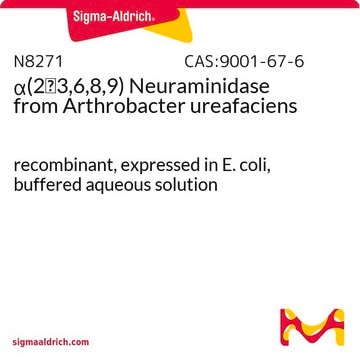72197
Neuraminidase from Vibrio cholerae
≥1.5 U/mL, specific activity ≥ 1.5U/mg protein
Synonym(s):
Acyl-neuraminyl Hydrolase, Receptor-destroying enzyme, Sialidase
Sign Into View Organizational & Contract Pricing
All Photos(1)
About This Item
Recommended Products
biological source
Vibrio cholerae
form
liquid
specific activity
≥1.5 U/mg protein
concentration
≥1.5 U/mL
density
1.00 g/mL at 20 °C
storage temp.
2-8°C
Looking for similar products? Visit Product Comparison Guide
Application
Neurminidase is used as a cell-surface probe for glycoconjugate distribution and in substrate specificity studies.
Unit Definition
1 U corresponds to the amount of enzyme which releases 1 μmol N-acetylneuraminic acid per minute at pH 4.5 and 37 °C (Neu5Acα(2-3,6)Galβ(1-4)Glc as substrate)
Other Notes
As a cell-surface probe of glycoconjugate distribution; Substrate specificity studies
Signal Word
Danger
Hazard Statements
Precautionary Statements
Hazard Classifications
Resp. Sens. 1
Storage Class Code
11 - Combustible Solids
WGK
WGK 1
Flash Point(F)
Not applicable
Flash Point(C)
Not applicable
Personal Protective Equipment
dust mask type N95 (US), Eyeshields, Gloves
Certificates of Analysis (COA)
Search for Certificates of Analysis (COA) by entering the products Lot/Batch Number. Lot and Batch Numbers can be found on a product’s label following the words ‘Lot’ or ‘Batch’.
Already Own This Product?
Find documentation for the products that you have recently purchased in the Document Library.
Customers Also Viewed
A K Shukla et al.
Analytical biochemistry, 158(1), 158-164 (1986-10-01)
A rapid and sensitive assay by high-performance liquid chromatography for determination of the activity and substrate specificity of sialidase (EC 3.2.1.18) and N-acetylneuraminate lyase (EC 4.1.3.3) is described. Sialic acids were separated on a strong anion-exchange resin using 0.75 mM
Bo Ram Kim et al.
Journal of enzyme inhibition and medicinal chemistry, 33(1), 1256-1265 (2018-08-22)
Sialidases are key virulence factors that remove sialic acid from the host cell surface glycan, unmasking receptors that facilitate bacterial adherence and colonisation. In this study, we developed potential agents for treating bacterial infections caused by Streptococcus pneumoniae Nan A
S W Whiteheart et al.
Analytical biochemistry, 163(1), 123-135 (1987-05-15)
Rat liver beta-galactoside alpha-2,6-sialyltransferase and Vibrio cholerae sialidase were used, in conjunction with CMP-N-acetyl-[3H]neuraminic acid, to probe the glycoconjugate distribution, sialylation state, and level of penultimate Gal beta 1-4GlcNAc residues on the surfaces of murine thymic lymphocytes. We report a
Weijia Wang et al.
Journal of virology, 87(8), 4642-4649 (2013-02-15)
In 2009, we successfully produced a high-yield live attenuated H1N1pdm A/California/7/2009 vaccine (CA/09 LAIV) by substitution of three residues (K119E, A186D, and D222G) in the hemagglutinin (HA) protein. Since then, we have generated and evaluated additional H1N1pdm vaccine candidates from
S Bhatt et al.
Philosophical transactions of the Royal Society of London. Series B, Biological sciences, 368(1614), 20120382-20120382 (2013-02-06)
Few questions on infectious disease are more important than understanding how and why avian influenza A viruses successfully emerge in mammalian populations, yet little is known about the rate and nature of the virus' genetic adaptation in new hosts. Here
Our team of scientists has experience in all areas of research including Life Science, Material Science, Chemical Synthesis, Chromatography, Analytical and many others.
Contact Technical Service







